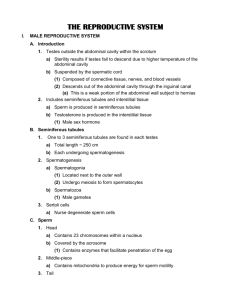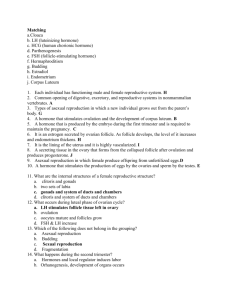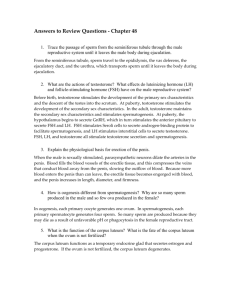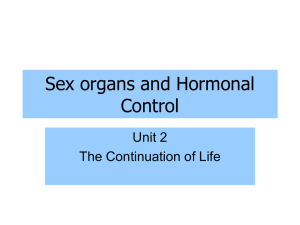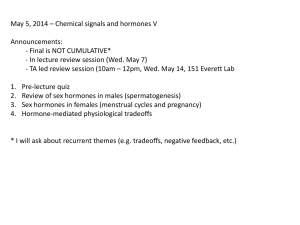chapter 27-the reprodctive system
advertisement
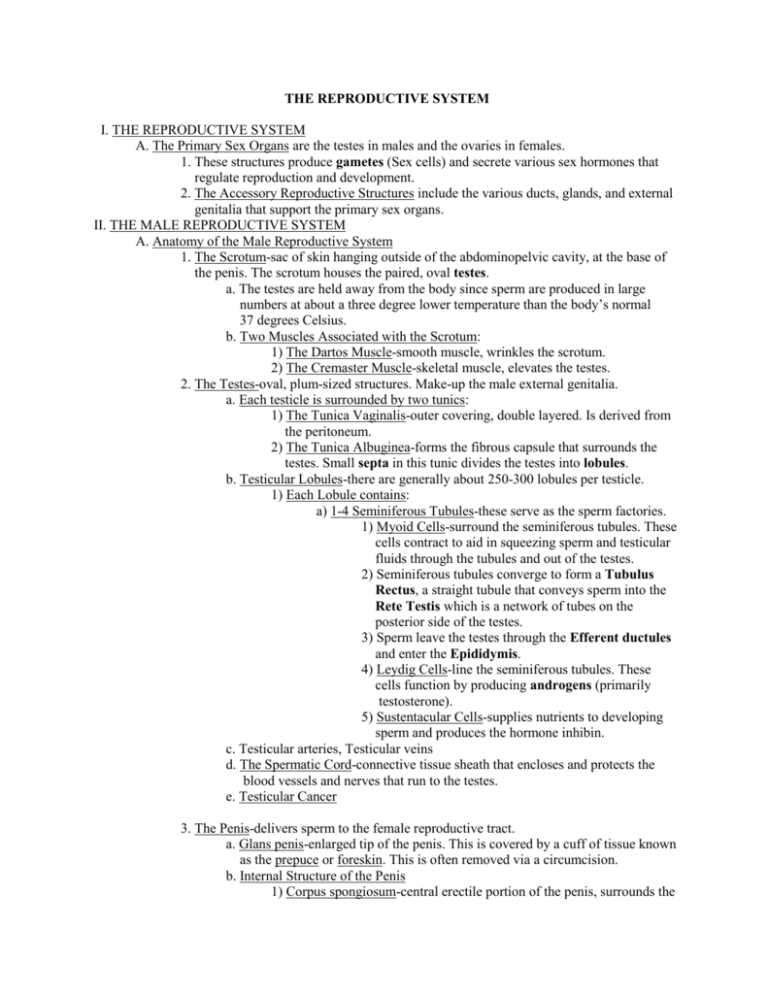
THE REPRODUCTIVE SYSTEM I. THE REPRODUCTIVE SYSTEM A. The Primary Sex Organs are the testes in males and the ovaries in females. 1. These structures produce gametes (Sex cells) and secrete various sex hormones that regulate reproduction and development. 2. The Accessory Reproductive Structures include the various ducts, glands, and external genitalia that support the primary sex organs. II. THE MALE REPRODUCTIVE SYSTEM A. Anatomy of the Male Reproductive System 1. The Scrotum-sac of skin hanging outside of the abdominopelvic cavity, at the base of the penis. The scrotum houses the paired, oval testes. a. The testes are held away from the body since sperm are produced in large numbers at about a three degree lower temperature than the body’s normal 37 degrees Celsius. b. Two Muscles Associated with the Scrotum: 1) The Dartos Muscle-smooth muscle, wrinkles the scrotum. 2) The Cremaster Muscle-skeletal muscle, elevates the testes. 2. The Testes-oval, plum-sized structures. Make-up the male external genitalia. a. Each testicle is surrounded by two tunics: 1) The Tunica Vaginalis-outer covering, double layered. Is derived from the peritoneum. 2) The Tunica Albuginea-forms the fibrous capsule that surrounds the testes. Small septa in this tunic divides the testes into lobules. b. Testicular Lobules-there are generally about 250-300 lobules per testicle. 1) Each Lobule contains: a) 1-4 Seminiferous Tubules-these serve as the sperm factories. 1) Myoid Cells-surround the seminiferous tubules. These cells contract to aid in squeezing sperm and testicular fluids through the tubules and out of the testes. 2) Seminiferous tubules converge to form a Tubulus Rectus, a straight tubule that conveys sperm into the Rete Testis which is a network of tubes on the posterior side of the testes. 3) Sperm leave the testes through the Efferent ductules and enter the Epididymis. 4) Leydig Cells-line the seminiferous tubules. These cells function by producing androgens (primarily testosterone). 5) Sustentacular Cells-supplies nutrients to developing sperm and produces the hormone inhibin. c. Testicular arteries, Testicular veins d. The Spermatic Cord-connective tissue sheath that encloses and protects the blood vessels and nerves that run to the testes. e. Testicular Cancer 3. The Penis-delivers sperm to the female reproductive tract. a. Glans penis-enlarged tip of the penis. This is covered by a cuff of tissue known as the prepuce or foreskin. This is often removed via a circumcision. b. Internal Structure of the Penis 1) Corpus spongiosum-central erectile portion of the penis, surrounds the urethra. It expands to form the glans penis. 2) Corpora cavernosa-paired erectile regions in the penis. 4. The Male Duct System-known as the accessory ducts. They occur in the following order: a. The Epididymis-is comprised primarily of the Duct of the Epididymis which functions by absorbing nutrients which are passed to sperm that are stored in the lumen. 1) Sperm are ejaculated from the epididymis (not the testes) into the Ductus deferens. b. Vas Defrens-a tube from the epididymis to the abdomen. It is approximately 18 inches long and serves as a passageway for sperm only. Sperm are moved through this tube via peristaltic motion. This is the structure that is cut in a vasectomy. c. Ejaculatory Duct-one inch long tube that penetrates the base of the prostate gland. This duct ejects sperm and seminal fluid into the prostatic urethra. d. Urethra-terminal duct that transmits both sperm and urine. Three sections of the Urethra: 1) Prostatic Urethra-passes through the prostate gland. 2) Membranous Urethra-2 inch tube that passes through the urogenital diaphragm. 3) Penile Urethra-6 inch tube that passes through the spongiosum of the penis. 5. Accessory Glands-these produce seminal fluids. a. Seminal Vesicles-located on the lower part of the posterior surface of the urinary bladder. These are paired structures that function by secreting alkaline, viscous fluid containing fructose which activates the whip-like action of the flagella of sperm. b. Prostate Gland-a single, doughnut-shaped gland inferior to the urinary bladder. This structure secretes a slightly acid fluid that gives semen its milky appearance. c. Bulbourethral or Cowper’s Gland-2 small pea-shaped structures located below the prostate gland. These secrete mucus prior to ejaculation which neutralizes the acidity of the female reproductive system. 6. Semen-refers to sperm plus seminal fluids. a. Has a pH of 7.2 to 7.6. b. Contains enzymes that activate the sperm. c. Average ejaculation is about 2.5 to 5 ml. d. Males release about 200 million sperm per ejaculation. e. Seminalplasmin-antibiotic that inhibits bacterial growth. f. Sperm account for only about 5% of the total semen weight. III. THE FEMALE REPRODUCTIVE SYSTEM A. Anatomy of the Female Reproductive System 1. Vulva-external genitalia. a. Mons pubis-a skin covered pad of adipose tissue over the pubic symphysis. This structure contains course pubic hair. b. Labia majora-paired folds of skin extending down from the mons pubis. This forms the outer border of the vulva. This structure is homologous to the scrotum. The labia majora contains numerous oil and sweat glands. c. Labia minora-longitudinal folds of skin medial to the labia majora. They unite to enclose the clitoris. d. Clitoris-cylindrical structure composed of erectile tissue and nerves; is homologous to the male penis. It enlarges during sexual excitement. e. Vestibule-cleft between the labia minora. This structure contains: 1) The External Urethral Orifice-opening of the urethra from the urinary bladder, located between the clitoris and vaginal opening. 2) Vaginal Orifice-opening to the vagina. It lies between the urethral orifice and the anus. It is bordered by the Bulb of the Vestibule (deep) and the Hymen (superficially). The skin covered region between the vaginal orifice and the anus is referred to as the Perineum. This is the region that is often surgically cut during childbirth. 3) Paraurethral Glands-embedded in the wall of the urethra, these secrete mucus. They are homologous to the Prostate Gland. 4) Bartholin’s Glands-embedded on either side of the vaginal orifice. These secrete a lubricating fluid during excitement. These are homologous to the Bulbourethral Gland. 2. Ovaries-primary female sex glands. a. They are paired structures that are almond-shaped and located on either side of the uterus. The ovaries contain germinal tissue in which are embedded thousands of Graffian follicles. Eggs (Ova) develop within these follicles. b. Functions of the Ovaries 1) Egg production (oogenesis) 2) Ovulation-discharge of eggs. 3) Secretion of the female hormones estrogen and progesterone. c. Support Ligaments Associated with the Ovaries 1) Mesovarian ligament-attaches to the broad ligament. 2) Ovarian ligament-attaches to the uterus. 3) Suspensory ligament-attaches to the pelvic wall. d. The ovaries contain the following: 1) Germinal Epithelium-outer covering of the ovaries. 2) Ovarian Follicles-oocytes in various stages of development. 3) Graffian Follicle-large, fluid-filled follicle that contains an immature ovum. These secrete estrogen. 4) Corpus luteum-empty follicle after ovulation. This secretes progesterone. 5) Corpus albicans-a degenerated corpus luteum containing white fibrous tissue. 6) Stroma-area between the follicles. 3. Uterus-womb, located in the pelvic cavity between the urinary bladder and the rectum. It is a pear-shaped structure that is about 3 inches long. a. 3 Divisions of the Uterus: 1) Fundus-dome-shaped portion above the fallopian tubes. 2) Body-central region of the uterus. 3) Cervix-lower portion, narrow. This part protrudes into the vagina and has an opening known as the external os that opens into the vagina. b. Layers of the Uternine Wall: 1) Perimetrium-outer layer, composed of epithelial tissue. 2) Myometrium-middle layer, muscular. This layer contracts during childbirth. 3) Endometrium-inner layer, the embryo implants here during pregnancy. This portion is divided into 2 parts: a) Stratum basalis-typically remains in tact. b) Stratum functionalis-is shed during menstruation. c. Functions of the Uterus: 1) Menstruation-shedding of the functionalis of endometrium. 2) Pregnancy-houses embryo during development. 3) Labor-aids in childbirth. d. Supportive ligaments Associated with the Uterus: 1) Broad ligament-attaches to either side of the pelvic cavity. 2) Uterosacral ligament-connects uterus to the sacrum. 3) Cardinall ligament-attaches the cervix and vagina to the pelvic wall. 4) Round ligament-between the layers of the broad ligament. 4. Fallopian (Uterine) Tubes-paired structures that attach to the uterus and extend upward and outward toward the sides of the pelvis and then curve downward to the ovaries. At the ovaries, these expand into a funnel-like section known as the infundibulum which opens into the abdominal cavity and contains finger-like projections known as fimbriae. a. Functions of the Fallopian Tubes: 1) Fimbriae sweep over the ovaries to pull the egg into the fallopian tube. Once inside the tube, the egg is moved along by muscle contractions and cilia activity. 2) Fertilization usually occurs in the fallopian tubes. b. These are the tubes that are cut in a tubal ligation. 5. Vagina-opens to the outside of the body via the vaginal orifice. a. Functions: 1) Serves as a part of the birth canal. 2) Receives the penis during copulation. 3) Passageway for menstrual flow b. Hymen-fold of connective tissue that partially closes the external opening of the vagina. c. Rugae-transverse folds of the vaginal mucosa. 6. Mammary Glands-located under the pectoralis major muscle. a. Composed of: 1) Adipose tissue-filling tissue of the mammary glands. 2) Lobes-15-20 of these in each mammary gland, are separated by adipose tissue. 3) Lobules-smaller compartments within the lobes, contain alveoli. 4) Ducts 5) Alveoli-milk secreting cells. 6) Suspensory ligaments-support the breasts. Also known as Ligaments of Cooper. b. There are usually 15-20 lobes separted by adipose tissue in the breasts. The lobes are divided into smaller lobules. The alveoli are arranged in clusters in each lobule. The alveoli produce milk which is expelled through a series of ducts. IV. PHYSIOLOGY OF THE MALE REPRODUCTIVE SYSTEM A. Spermatogenesis-sperm formation, occurs in the seminiferous tubules. 1. This process is regulated by the hormone Follicle Stimulating Hormone (FSH). 2. Stages in Spermatogenesis a. Spermatogonium-diploid, 46 chromosomes. b. Primary Spermatocyte-chromosomes in tetrads. c. Secondary Spermatocyte d. Spermatids-haploid, contain single chromosomes. e) Spermatozoa or Sperm B. Erection-enables penetration into vagina. Steps in this process include: 1. Impulses from the parasympathetic division of the ANS promote the release of nitric oxide (NO) which causes vasodilation of the arteries and vasoconstriction of the veins of the penis. 2. More blood enters the penis than leaves, allowing blood to fill the spongy tissue of the cavernosa and spongiosa causing the penis to become larger and rigid. 3. Emission-the movement of semen from the genital ducts and glands into the prostatic urethra. 4. Ejaculation-sympathetic response that causes the urethral sphincters to close and propels the semen from the prostatic urethra to the exterior. V. PHYSIOLOGY OF THE FEMAL REPRODUCTIVE SYSTEM A. Oogenesis-occurs in the ovaries, begins at puberty. 1. This process is regulated Follicle Stimulating Hormone (FSH). 2. Stages in Oogenesis: a. Primordial follicles (Oogonium)-these are diploid. b. Primary Oocyte-these are in prophase I of meiosis. They remain in this stage until puberty. There are about 1 million of these per ovary. c. Secondary Oocytes/First Polar Body 1) After puberty, FSH and LH causes meiois I to resume, resulting in 2 cells of unequal size, both with 23 dyads. The larger cell is the Secondary Oocyte and the smaller one is the First Polar Body. 2) The Secondary Oocyte contains almost all of the cytoplasm. 3) Ovulation occurs at this stages and does not continue unless oocyte is fertilized by a sperm. d. Ootid/Secondary Polar Bodies 1) If fertilized, the secondary oocyte continues into meiosis II producing two more unequal sized cells-the Ootid (larger cell) and Secondary Polar Bodies (smaller cell). 2) All polar bodies disintegrate leaving the ootid to become the mature ovum. B. Menstrual Cycle 1. Hormones Associated with the Menstrual Cycle a. Gonadotropin Releasing Hormone (GnRH)-produced by the hypothalamus, this hormone influences the anterior lobe of the pituitary gland to produce the following hormones: 1) Follicle Stimulating Hormone (FSH) which functions by: a) Stimulating the growth of the ovum within the follicle. b) Stimulating release of estrogen by the growing follicle. 2) Lutenizing Hormone (LH) which functions by: a) Inducing ovulation b) Stimulating the ruptured follicle to become the corpus luteum. c) Stimulating the corpus luteum to produce progesterone. b. Estrogen-produced by the growing follicle. This hormone functions by: 1) Stimulating growth of the endometrium. 2) Stimulating the development of secondary sex characteristics. 3) Inhibiting the release of GnRH and FSH so no other oocytes will be produced. c. Progesterone-produced by the corpus luteum. This hormone functions by: 1) Stimulating further growth of the endometrium during pregnancy. 2) Inhibiting the production of GnRH and Prolactin. 2. Phases of the Cycle-lasts about 28 days. a. Menstrual Phase-first 4 or 5 days of the cycle. 1) Functionalis layer of endometrium is shed. This includes about 6-9 ounces of blood, mucus and epithelial tissue. 2) FSH begins to cause the primary follicles to become secondary follicles. b. Preovulatory or Follicular Phase-days 6-13. 1) High levels of FSH causes secondary follicle to develop into a mature follicle (Graffian Follicle). 2) Estrogen produced by the growing follicle causes the endometrium to rebuild. 3) On about the 14th day, estrogen acts as a feedback mechanism to inhibit FSS production and inhibit LH production. This leads to ovulation. c. Postovulatory Phase or Luteal Phase-days 15-28. 1) Following ovulation, the level of estrogen drops slightly and LH stimulates the ruptured follicle to become the corpus luteum. 2) The corpus luteum now secretes progesterone and estrogen which is responsible for preparing the endometrium for implantation. 3) Near the end of this phase, FSH secretion gradually increases and LH secretion decreases. 4) The dominant hormone during this phase is progesterone. d. If fertilization does not occur: 1) The rising levels of progesterone and estrogen from the corpus luteum inhibits GnRH and LH production, thus causing the corpus luteum to degenerate and become the Corpus albicans. 2) With the disappearance of the corpus luteum, the production of estrogen and progesterone decreases causing the functionalis of the endometrium to breakdown and the menstrual flow to begin. 3) The decreased amounts of estrogen and progesterone also bring about a new output of FSH causing a new follicle to develop. a) Birth control pills function by keeping estrogen and progesterone levels high so no new ouput of FSH will cause a new follicle to form. e. If fertilization does occur: 1) The corpus luteum is maintained for about 4 months during which time it continues to produce estrogen and progesterone which maintains the endometrium. 2) After the placenta is formed, it begins to produce the hormone Human Chorionic Gonadotrophic Hormone (hCG) which continues to maintain the corpus luteum. The presence of hCG can be detected in urine and blood to check for a positive pregnancy. 3) The placenta also becomes active in estrogen production to support pregnancy and progesterone to support breast development and lactation. VI. CLINICAL TERMS




